Figure 11-15.—Two typical types of RTDs.
thermocouples. These devices sense variable
temperatures at a given point in the system and transmit
the signals to a remotely located indicater.
Resistance Temperature Detectors
The RTDs operate on the principle that electrical
resistance changes in a predictable manner with changes
in temperature. The elements of RTDs are made of
nickel, copper, or platinum. Nickel and copper are used
to measure temperatures below 600°F. Platinum
elements are used to measure temperatures above 600°F.
Figure 11-15 shows two typical types of RTDs.
Like bimetallic thermometers, RTDs are usually
mounted in thermowells. Thermowells protect the
sensors from physical damage by keeping them isolated
from the medium being measured. This arrangement
also lets you change the RTD without securing the
system in which it is mounted. This makes your
maintenance job easier.
As temperature increases around an RTD, the
corresponding resistance also increases proportionally.
The temperature applied to an RTD, if known, gives you
a known resistance value. You can find these resistance
values listed in tables in the manufacturers’ technical
manuals. Normally, only a few resistance values are
given.
To test an RTD, you need to heat it to a specific
temperature. At this temperature, the resistance of the
RTD should be at the resistance shown in the
manufacturer’s table. The most common method of
heating an RTD is to use a pan of hot water and a
calibrated thermometer. Some newer ships and repair
activities test RTDs using. a thermobulb tester. This
method is more accurate and easier to use. For specific
instructions, refer to the manufacturers’ technical
manuals supplied with the equipment.
The most common fault you will find with an RTD
is either a short circuit or an open circuit. You can
quickly diagnose these faults by using digital display
readings or data log printouts. By observing the reading
or the printout, you may find that the indication is either
zero or a very low value. A malfunction of this type
means a short circuit exists in either the RTD or its
associated wiring. A very high reading, such as 300°F
on a 0°F to 300°F RTD, could indicate an open circuit.
You should compare these readings to local
thermometers. This precaution allows you to ensure that
no abnormal conditions exist within the equipment that
the RTD serves.
11-8

